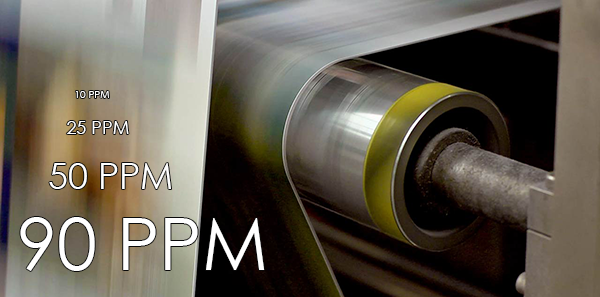When I first started working at A&A Office Systems, I'll admit, I didn't know a single thing about copiers, printers or MFPs. Three years later, I like to think I know maybe a couple things, but at the beginning, I had questions that seemed so obvious, I felt sheepish to ask in the first place.
For example, I actually had to raise my hand and ask, "What does PPM mean on a printer?" Thankfully, I work at an pretty understanding company, and I was gently informed that PPM means "pages per minute." I didn't know that! Simple, right? Thanks for Googling! We'll see you next time here on The A&A Blog...
...Just kidding. Where's the fun in that? There's more to learn!
It's important to know that PPM refers to standard letter pages of plain black text, and not color images, or a combination of any of these things on paper larger than 8.5x11. Some manufacturers adhere to the Method for measuring digital printing productivity governed by the International Standards Organization, or ISO, in ISO/IEC 24734:2014. However, not all do, and the standard itself states that it is not a replacement for a manufacturer's rated speeds.
Commercial desktop printers, such as those you might find in a small business or in a home office, run the range from 3 pages per minute to 20, depending on the model and the print method. Inkjet printers usually have a PPM rate of 3 to 13 PPM, while laserjet printers tend to run faster with rates between 12 and 20 PPM. Again, this is, just pages of black text. Color will print at a slower rate. Typical desktop printers are at the lower end of the spectrum, but suffice for the occasional email, report, term paper, or recipe.
For anything more than the occasional black and white document, a copier or multifunction printer is your ticket to the PPM fast lane! MFPs run the gamut from 25 PPM up to 90 PPM, and the speed you want for your business or organization is largely dependent on your print volume.
Read More: How Do I Recycle My Toner and Ink Cartridges?
So Then What Print Speed is Right For Me?
Good question! You will probably never get the same answer twice, even from the sales team here at A&A. You will probably hear that it depends on your industry and document length and paper size and if you print more color or more black and white, and so on. And that's all true! Finding the right fit can be a challenge.
You could just go all out and purchase a 90 PPM copier, but if your print volume is low, that's like buying a Maserati to drive to your job three streets over. You spent way more on your MFP than you have to. Conversely, if you have a high print volume and decide to play it frugal, a machine with a low PPM will not only leave you waiting for simple jobs, but you will put incredible wear and tear on the parts. You could even end up spending more in the long run.
After pulling our collective heads together here at A&A HQ, we've developed these general guidelines based on monthly print volume:
5,000 to 10,000 Pages
25 - 35 PPM
Good Possible Fit:
Small business offices
25,000 to 35,000 Pages
50 - 60 PPM
Good Possible Fit:
Medium business offices
Law firms
Accountants
50,000 + Pages
75 - 90 PPM
Good Possible Fit:
Schools
Towns

Whew! If you had no idea "What does PPM mean?" was such a loaded question, join the club! I think the most important takeaway isn't just what PPM stands for, but how pages per minute tie into your monthly print volume and finding the right copier for you.
Most manufacturers will list the PPM rate right on their product page. Ricoh / Savin builds the PPM right into the model number! A Savin C2525 has a PPM rate of 25, and a Savin MP 9002SP has a PPM rate of 90.
Hopefully this blog answered not only your simple question, but better prepared you to make purchasing decisions in the future.
Now that you know a little more about PPM, why not download our free eBook to learn more about the print technology in your office?

